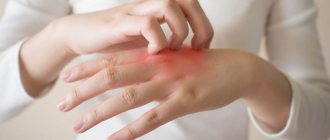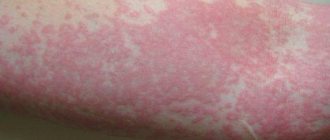Seasonal allergies (hay fever) are an allergic response of the body, which is classified as the so-called immediate type. A characteristic feature of the disease is a clear seasonality (repeating at certain times of the year). This period coincides with the flowering of various plants.
Reference.
As medical statistics show, clinical symptoms of the disease manifest themselves in specific patients every year throughout their lives. Moreover, annual coincidences concern both specific months (for example, May/June) and dates. Exceptions are weather anomalies, when plant flowering is delayed or occurs earlier due to uncharacteristic changes in weather conditions (abnormal heat or, conversely, sudden cold snap). Persons prone to seasonal allergies should also take into account their stay in a certain area, which is the natural habitat of a variety of plants that cause their allergies. Leaving such a region often leads to a complete cessation of the negative symptoms of the disease.
Attention!
Allergists recommend their patients to take timely and competent measures before the hay fever season. Now medical science has in its arsenal enough high-quality medicines with which you can successfully survive a dangerous period. The selection of the optimal option for the treatment and successful prevention of seasonal allergies is carried out after examinations and medical history.
Patients diagnosed with this disease should be aware that there are three waves that cause negative symptoms (pollen waves):
- March, April. Flowering trees.
- May-June, mid-July. Flowering of cereals and herbs in meadows (wheat, rye, wheatgrass, fescue, timothy, etc.).
- Aug. Sept. Flowering of wormwood, ragweed, quinoa, sunflower, corn.
Note.
More details about this can be found in the table.
Ambrosia plant - what does it look like, where does it grow, when does it bloom?
Everyone knows and has seen such a plant as ambrosia, since it has a habit of growing both in rural areas and in urban areas. The thing is that ragweed is a weed. The peculiarity of the grass is that it can be annual or perennial. Its stem is straight and its height can reach up to two meters.
INTERESTING: Ragweed was first noticed in North America and it is believed that the seeds of this plant were accidentally introduced to Europe along with clover seeds in the 18th and 19th centuries. There are about 40 varieties of ragweed in North America, but only three are found in our area. Artemisia ragweed is also used in medicine. Homeopathic medicines are prepared from it.
Ragweed is a strong allergen; moreover, the pollen of this grass is considered a “quarantine” allergen. The root system of ragweed is very strong. Some roots can extend their roots up to 4 meters deep. Ambrosia leaves are long and dissected, up to 13-15 centimeters long. The leaves are green on the upper side and silvery on the underside.
IMPORTANT: Ambrosia has several subspecies and, depending on them, blooms at a certain time during the warm season. In general, the flowering period begins in July and ends in October.
Where is ragweed most common:
- Ukraine (here the plant gained global distribution after the Great Patriotic War due to the large number of moving vehicles).
- Caucasus (northern part)
- Russia (southern part and south-eastern regions)
- Primorye
- Volga region
INTERESTING: Ambrosia has one very unpleasant feature, as a plant, its deep roots take absolutely all nutrients and useful substances from the soil. After such depletion, the soil becomes completely barren and incapable of growing crops.
Ambrosia leaf
Mature plant
Allergies can be caused by the flowering of three groups of plants, these are:
- Trees, primarily deciduous: birch, alder, maple, poplar, oak, hazel, ash and others. Coniferous pollen rarely causes hay fever, but this possibility cannot be completely ruled out. Tree dusting season is April, May.
- Cereals, mostly wild: timothy, wheatgrass, bromegrass, foxtail, bluegrass and others. Pollen from cultivated cereals - rye, oats, wheat, barley, corn - is less allergenic. Cereals bloom in the first half of summer - in June-July.
- Weeds - wormwood, Chernobyl, quinoa, in the southern regions - ragweed and others. Weeds can remain dusty until autumn. Allergies to them go away with the first frost.
The likelihood of an allergy from the pollen of a particular plant is influenced not by age, but by the place where a person lives and the prevalence of the plant in that place. An urban child is unlikely to develop an allergy to wheat or corn pollen - he simply does not live in the places where they grow. A child from Surgut will not get hay fever from ragweed blooms until he moves to live in the south. But a child from a metropolis or from a village will equally likely respond to the flowering of a birch: it can be found not only in the forest, but also in city yards.
It is important!
For children in the first year of life, food allergies are more common.
If a child under one year of age develops allergies, then first of all you should pay attention to the mother’s diet during breastfeeding and the choice of formula during artificial feeding. For children prone to allergies, it is better to use special hypoallergenic mixtures, for example, Nutrilak Premium Hypoallergenic.
Seasonal allergy to ragweed: symptoms, signs in adults and children
Ragweed is a strong seasonal allergen. In a person who is not predisposed to allergies and has little sensitivity, it can cause mild symptoms. For allergy sufferers, people with weak immunity and disrupted hormonal levels, allergies become unbearable and require intervention.
IMPORTANT: Humans are sensitive to ragweed pollen. In most cases, the first symptom of an allergy is rhinitis (stuffy nose). In some cases, pollen manifests or aggravates asthma.
Symptoms of ragweed allergy in adults:
- Rhinitis (mild or severe obstruction of mucus and air in the nasal sinuses).
- Itching in the sinuses, in the nasopharynx, on the palate, on the tongue, in the oral cavity.
- Sore throat (ranging from discomfort to pain, compare to sore throat).
- Cough (due to choking or very itchy palate)
- Conjunctivitis (due to pollen getting into the eye or rhinitis, due to obstruction of the nasal sinuses and a blocked, inflamed tear duct).
- Urticaria (itching, redness of varying strength in different parts of the body).
- Quincke's edema
Symptoms of ragweed allergy in children:
- Stuffy nose
- Snot
- Sneezing
- Dry cough
- Hives
- Tears
- Itching on mucous membranes
Allergy symptoms
Seasonal Allergy Symptoms
Signs of hay fever have characteristic features - long-term painful wave-like sneezing, redness and burning of the mucous membranes of the eyes, their swelling, discharge from the eyes and nose, unbearable itching in the nasopharynx, difficulty nasal breathing.
The most common symptomatology is acute inflammation of the mucous membranes:
- Eye.
- Skin.
- Nasopharynx.
Less common signs of hay fever:
- Disorders of the digestive system.
- Problems with the heart and blood vessels.
- Functional malfunctions of the genitourinary system.
- Nervous disorders.
When does a ragweed allergy begin and end?
As already mentioned, the flowering period of ragweed begins in July and at the same time people experience the first symptoms of allergies - rhinitis, snot and itching in the sinuses. As the plant blooms vigorously, allergies may intensify.
The greater the amount of ragweed that grows in the area in which you live, the stronger the allergy may manifest itself (for example, in rural areas it is stronger than in the city). The peak of allergies occurs in August and September and a person begins to feel a decline in October.
IMPORTANT: The allergy goes away very slowly, first the itching may subside and hives may go away, then nasal congestion and sneezing, until complete recovery.
Cross allergy
There is also what is called cross-reaction. This means that the body of an allergic person reacts to pollen and food products that contain a certain allergen. The risk group also includes similar herbal medicines.
A person who knows the enemy (allergen) by sight is able to take measures to prevent contact with the irritant. In this case, it is possible to reduce negative symptoms or get rid of the disease altogether.
| Pollen allergen | Food |
| Pollen from birch, alder, hazel | |
| Pollen wormwood | |
| Sunflower pollen | |
| Ambrosia pollen | |
| Pollen of grasses, rye | |
| Fragrant herbs | |
| Pollen from many plants |
Treatment of ragweed: what to drink if you are allergic to ragweed?
Any allergy can be either curable or treatable (that is, symptoms can be eliminated for a while). The best treatment is to leave the place of residence that has a large amount of the allergen (i.e., move temporarily). But it is almost impossible for a modern person to do this (work, lack of money, temporary housing, and so on).
The most effective remedy that a person can do for himself to prevent the development of allergies is timely vaccination. That is, a minimal amount of allergen is introduced into the body and it develops immunity to it. This is done far before the ambrosia flowering period.
However, not everyone agrees to vaccination, because from such therapy you can expect any results, both improvement of your condition and deterioration. That is why the most popular medications for ragweed allergies are antihistamines (allergy medications). Such products improve well-being by increasing immunity, normalizing hormonal levels and partially removing the allergen from the body.
What you can take:
- Suprastin
- Diazolin
- Eden
- Alleron
- Tsetrin
IMPORTANT: The list of medications is quite large and varies depending on the pharmacy and country. It is important to take the product correctly, following the regimen and not exceeding the dosage. If you notice that the selected drug has stopped working, temporarily change it to a different name.
How can you cure an allergy to ragweed?
News from Taganrog, Rostov region
With the arrival of the beautiful autumn season, unfortunately, many people experience a seasonal allergy to blooming ragweed. And the warmer the autumn, the more pronounced the symptoms of the disease. What should those who suffer from allergic manifestations do, how to deal with an unpleasant and even dangerous illness? Today we want to give you some medical recommendations on this matter, and in addition, time-tested advice from traditional medicine.
Ambrosia pollen is the most powerful allergen among all flowering plants and trees. The seasonal hay fever it causes can be very severe, which forces some people to either take sick leave or travel to other regions for the flowering period. Unfortunately, it is impossible to get rid of an allergy to ragweed one hundred percent. Well, the use of antihistamines will only help relieve the symptoms of allergic rhinitis, but not for everyone. Treatment with folk remedies is the provision of additional assistance in reducing allergic manifestations. The positive effect is achieved through the correct combination of traditional methods of protection and medication.
Avoiding mistakes in treatment
During illness, some people make typical mistakes in treatment, which, of course, cannot be done. And this is what allergists recommend. It should be remembered that you need to take antihistamine tablets daily throughout the entire period of ragweed flowering, even if the symptoms have subsided. You need to complete the course of taking them only 5-7 days after the ragweed has faded. Oral antihistamines should be started three weeks before ragweed season. When using antiallergic drops for a runny nose, it is necessary to take into account that their long-term use is addictive and after some time they stop working. Therefore, it is necessary not only to alternate between different types of nasal drops, but to arrange regular “days of rest” from them, i.e. For three days we drip some, for three days we drip others, and we skip one day. If you are very concerned about tearing, you should periodically help the mucous membranes of the eyes and lacrimal glands with special drops - anti-allergenic eye drops. These medications will be prescribed to you by your doctor and recommended at any pharmacy. However, do not forget that allergic tears are not only a direct reaction to pollen, but also a consequence of allergic rhinitis.
Drink more water
Numerous folk remedies for combating allergies can be conditionally grouped into two categories: the first group of methods includes taking synthetic and natural sorbents; the second is, to one degree or another, aimed at maintaining immunity. One of the very first and most important recommendations for adults and children suffering from ragweed pollen allergies is to drink plenty of clean drinking water every day. The fact is that sorbents for hay fever do not have a strong antitoxic effect; they are more indicated for food allergies. But a quantitative increase in clean water drunk per day forces the kidneys to work harder and thereby cleanses the blood naturally. You should drink exclusively still water. You can use regular filtered, table or mineral-table. If you drink regular or table water, do not forget to put 1 grain of sea salt or 3-4 grains of rock table salt under your tongue before drinking a glass. It is very good for allergy sufferers to use natural diuretics. But not watermelon! Despite all its usefulness and excellent kidney-sparing diuretic effect, this berry is strictly prohibited for those suffering from ragweed pollen. In the vast majority of cases, watermelon makes you feel worse, and allergy symptoms become severe.
Cleansing the body of toxins
You should know that the No. 1 foods that help cleanse the blood are celery and grapefruit. During the flowering of ragweed, you must include petiole celery juice and grapefruits in your daily diet (you can use natural, freshly squeezed juice). The help they provide to the body is clearly invisible, but priceless. Celery and grapefruit are the most powerful natural blood purifiers. They contain not only all the necessary vitamins that are necessary to maintain hematopoietic function, but also microelements necessary for the immune system such as calcium, zinc, phosphorus, potassium and iron. These natural antioxidants will help you cope with a stressful period for your body more easily. Grapefruits should be eaten or juiced without removing the membrane from the segments. The daily amount of juice, which must be salted before drinking, is no more than 100-150 ml. You should drink juice in the evening, after dinner. Eat grapefruits in the afternoon, best of all - half or a whole fruit just before bed. It is also good to drink lemon water. For morning use, prepare it according to the following recipe: in the evening, put a 1 cm thick slice of lemon, cut into 4 parts (along with the peel), into a glass of table water, leave to steep overnight, covering the glass with a saucer. After waking up, first drink a glass of regular purified water, after 20 minutes - lemon water, and 20 minutes after that, start breakfast. Adults and children suffering from allergies to ragweed can periodically - every two weeks - be provided with additional help to the nasal mucosa with drops of Kalanchoe or aloe juice. There is also a good remedy for inflamed eyelids and hard-working tear glands - make a lotion from green tea bags or chamomile every night before bed.
Effective and safe folk recipes for ragweed allergies
4 tbsp. l. dry nettle leaves pour 1 liter of cold water. Boil for 15 minutes. Let cool and strain. Drink throughout the day.
4 tbsp. l. chopped horsetail herb pour 0.4 liters of boiling water. Leave for 30 minutes covered, strain. Drink during the day in four doses.
1 tbsp. l. dry chopped dill, pour 0.5 liters of boiling water. Leave for at least 1 hour. Strain and drink in three doses - before breakfast, lunch and dinner.
When using traditional methods of treating ragweed pollen allergies, do not expect an instant and visible effect from them - they will not immediately remove a runny nose, cough or tears. But when used correctly, they will definitely strengthen the body and contribute to an easier course of the disease.
Prepared by Elena Veksler
Modern medications for ragweed allergies: injections, tablets: which is better and more effective?
Allergies begin to develop even when a small particle of pollen reaches the mucous membrane of the nose or throat through breathing. Severe allergies can be eliminated by taking a number of anti-allergy medications. In cases where a person has a very weak immune system or hormonal imbalance (previous illness, childbirth, abortion, pregnancy), doctors may recommend vaccination.
For example, an injection called “Diprospan” (there are other names of medications). The drug is administered intramuscularly and can be administered to both adults and children. You should consult your doctor before administering the medication. The dosage of the drug is also regulated by the doctor. You should study your characteristics before administering the medicine, as it has contraindications: gastritis, ulcers, kidney and liver diseases.
IMPORTANT: The injection acts much faster and stronger than the tablet. A person can feel the first relief after two or three hours (the sinuses do not swell and the itching slowly goes away).
Myths and dangerous misconceptions in the treatment of hay fever
The worst misconception when allergies appear due to flowering in the spring is the belief that the disease can be cured on your own, without the help of a doctor. Only a specialist, after diagnosis, will be able to determine which plants you are allergic to. Uncontrolled use of medications or folk remedies can only worsen a person’s condition. A professional allergist selects an individual treatment regimen for each patient. Being not an expert in this field, it is difficult to determine the selection and dosage of drugs correctly. If hay fever is treated incorrectly, complications often begin. Then, instead of one disease, a whole complex of diseases develops, the cure of which will be much more difficult and longer in time.
What are the best nasal and eye drops for ragweed allergies?
As already mentioned, rhinitis due to an allergic reaction to ragweed occurs in most people who are sensitive to pollen. Along with rhinitis, inflammation of the lacrimal canal may occur. If there is inflammation and obstruction of the tear, the person develops conjunctivitis.
IMPORTANT: Eye drops and nasal drops will help you cope with a stuffy nose and sore eyes.
Eye drops:
- Zaditor – removes inflammation of the eye and makes allergies milder.
- Ketotifen – relieves allergic inflammation
- Patanol – eliminates allergic inflammation, itching, redness
- Optivar –
Nasal drops:
- Beconase – eliminates allergic reactions, eliminates inflammation of the sinuses.
- Nasonex is a concentrated remedy to combat allergic rhinitis.
- Aqua – Maris – moisturizes and soothes the nasal mucosa
- Evkazoline – pierces the nose, eliminates inflammation of the sinuses.
Drops for the treatment of allergies from ragweed
Symptoms of hay fever
Hay fever is a seasonal disease; its symptoms appear only when the corresponding allergen plant blooms. The condition usually worsens in the morning, when there is especially a lot of pollen in the air. Dry and windy weather also contributes to poor health, but when it rains, the air is cleared of pollen, and the disease recedes.
The main symptoms of the disease are:
Allergic conjunctivitis
Allergic conjunctivitis is a typical manifestation of hay fever. The eyes begin to water, the eyelids swell and itch, the mucous membranes turn red, it hurts to look at the light, it feels as if sand has gotten into the eyes.
Allergic rhinitis
Another typical manifestation of hay fever is allergic rhinitis. The nose is itching, nasal breathing is disrupted, there is copious mucous discharge, and bouts of sneezing - sometimes 10-30 sneezes in a row.
Asthmatic attacks
In severe cases, hay fever can manifest itself in the form of asthmatic attacks.
Hives
Urticaria and allergic dermatitis may also occur.
More about the symptom
New generation drugs for ragweed allergies
New generation drugs are called drugs of hormonal origin. They are also often called “third” generation drugs. They act on the body by changing hormonal levels.
IMPORTANT: The effect of the hormonal drug is very simple - it does not allow the body’s immune cells to release active substances. As a result, the body is stronger and resists all unpleasant allergic symptoms, preventing any recurrence.
The most popular drugs for internal use:
- Desloratadine – effectively fights year-round allergies
- Levocetirizine – prevents allergies from developing, weakens the course of allergies.
- Telfast - reduces allergic symptoms, eliminates rhinitis and urticaria.
IMPORTANT: Hormonal medications for allergies can be either tablets or injections, as well as nasal drops.
Folk remedies for ragweed allergies
Traditional medicine has established itself as a faithful “helper” and friend of man in getting rid of many diseases. If we are talking about allergies, then here it acts as a remedy that can ease strong, manifesting symptoms. In addition, traditional medicine recipes for the treatment of ragweed allergies should be taken in combination with drug treatment and only when you are not sensitive to certain herbal preparations.
What can be used to treat ragweed allergies:
- Celery is the green part. Ground bunches can be mixed with honey and taken after infusion, several spoons per day. Celery removes toxins, including allergens, from the blood.
- Nettle - leaves. A boiled decoction of leaves is mixed with rosehip decoction and drunk up to 5 times a day with small spoons. The product strengthens the immune system, thereby helping it fight allergens. The same recipes include pure rosehip decoction and decoction with spruce needles.
- Calendula - flowers. An infusion of flowers (not a decoction, but simply boiled water and infused flowers) helps relieve allergic symptoms. Drink half a glass twice a day.
- Woodweed is the root. It should be boiled for at least 15 minutes and drunk only in tablespoons three times a day. Helps eliminate unpleasant allergy symptoms or at least make them less severe.
- A series of leaves. They effectively eliminate hives on the skin (it is recommended to take baths with a decoction of the leaves).
- Burdock is a root. Boil and infuse the roots for up to 12 hours. Drink with sugar and milk. The product helps fight the allergen that has entered the body, reducing its symptoms.
- Oak bark - a decoction or infusion - perfectly fights skin allergies. Recommended for external use.
- Peppermint - leaves. The decoction helps relieve symptoms and slightly stabilize hormonal levels, calm and relax.
- Clover decoction or juice - intended for external use as compresses, perfectly combats tearing.
Traditional medicine in the fight against ragweed allergies
Causes of hay fever
An allergic reaction is a disruption of the immune system when a substance is recognized by the body as a harmful agent (which “rightfully” includes pathogens and cancer cells), and the body begins to fight this substance by producing antibodies. In the case of hay fever, pollen turns out to be such an agent (allergen).
Hay fever is usually caused by pollen from wind-pollinated plants. Such pollen has a microscopic size - 0.02-0.04 mm, and therefore easily penetrates the respiratory tract and is absorbed into the blood and lymph.
Like any other allergy, hay fever develops only if the body is predisposed to an allergic reaction. This predisposition can be inherited. However, contact with the allergen does not immediately lead to the appearance of obvious allergic symptoms. According to the results of recent epidemiological studies, 10% of children and 20-30% of adults in Russia suffer from hay fever. People aged 10 to 40 years are most often affected; in children under 3 years of age, hay fever is rare; boys under 14 years of age are 2 times more likely to get sick, and between the ages of 15 and 50 years - females. Among city residents, the incidence is 4–6 times higher than among rural residents.
Currently, about 50 plant species are known to cause hay fever. In the vicinity of Moscow in April-May trees bloom: birch, alder, oak, hazel, poplar, ash, maple. In June-July, pollen from flowering cereal grasses - bluegrass, timothy and many others - gets into the air. Weeds also contribute: dandelion begins to “gather dust” at the end of May, and in June plantain, sorrel and nettle join it. Flowering of weeds continues until autumn. In August-September, wormwood and quinoa bloom. In the southern regions of the country (in the Stavropol and Krasnodar Territories), ragweed blooms during this period, whose pollen is one of the most powerful allergens.
Poplar fluff, the appearance of which in Moscow is traditionally associated with the beginning of the allergy season, is not itself an allergen - it is not pollen, but fruit. Plus it's too big. But down is an excellent carrier of pollen from other plants, which is a true allergen.
How to treat ragweed allergy in children?
Unfortunately, allergic predisposition occurs in every third child. The reasons for this are the unfavorable modern ecology, poor quality of food, preservatives, as a result of which the immune system suffers and weakens. In the summer season, during the flowering period, allergies can manifest themselves more strongly and cause unpleasant consequences.
How allergies manifest in children:
- Irritation of mucous membranes in the mouth, nose, and throat
- Itching in the throat, ears, nose, eyes, skin
- Sore throat, pain when swallowing, enlarged and swollen tonsils.
- Slight increase in temperature (in rare cases).
How to treat allergies in children:
- Treatment occurs only with medication
- Treatment is prescribed by a doctor, focusing on diagnoses and determination of the exact allergen.
- In addition to prescribing the drug, the doctor also adjusts the nutrition menu, removing foods with a high risk of allergic manifestations.
- Depending on age, the doctor prescribes anti-inflammatory drugs, antihistamines or even hormonal drugs.
How to treat an allergy to ragweed in a child?
How to treat an allergy to ragweed during pregnancy and breastfeeding?
Allergy in pregnant women is, first of all, a protective reaction of the body to the presence of allergens. Pregnant women should definitely treat and eliminate allergies in every possible way so as not to harm the fetus, but this should be done correctly, in consultation with a doctor.
Most medications are prohibited during pregnancy, because the substance in the drug can cause harm rather than benefit. The frequency of allergy symptoms and their strength depends only on the woman’s individual predisposition and her state of health. For some, the allergy to ragweed is very tolerable and you can simply wait it out; for others, it may even require hospitalization.
How does a pregnant woman manifest an allergy to ragweed:
- At first, you may feel itching in the nose, a profuse runny nose and a stuffy nose.
- Then you can feel itching in the ears and corners of the mouth, on the roof of your mouth and in the throat.
- After this, your throat may become sore and swallowing food will become worse.
- Along with this, watery eyes and itching appear on the skin.
- Sneezing or coughing occurs when allergies are complicated; each sneeze or cough increases irritation of the mucous membrane of the throat and palate, causing tears, soreness and pain.
- Along with all the symptoms, a woman may feel fever, abdominal pain, and headache.
IMPORTANT: If you are predisposed or have severe symptoms, you should consult a doctor so that, depending on your stage of pregnancy and health condition, the specialist will prescribe safe first-generation antihistamines.
Allergy to ragweed in pregnant women
Third generation drugs
If you have an allergy, you should always have antihistamines in your home medicine cabinet.
Officially, third-generation drugs have not yet been developed, however, unofficially, improved second-generation drugs are included in this group. This group is characterized by a rapid onset of action and high efficiency. The drugs have fewer side effects. Individual intolerance is possible. They can be used both to relieve allergy symptoms and for long-term treatment of the disease. They do not affect heart rate. The best third-generation drugs include Cetrin, Erius, Xizal, and Fexofen.
- Cetrin. Available in the form of tablets (contraindicated in children under 6 years of age) and in the form of syrup (contraindicated in children under 2 years of age). The effect lasts up to 24 hours. Effective in the development of edema. Syrup as part of complex therapy relieves spasms in bronchial asthma. It has virtually no contraindications. Should be used with caution in elderly people.
- Erius. Available in the form of tablets (contraindicated in children under 12 years of age) and syrup (contraindicated in children under 1 year of age). It works almost immediately. Duration of action is up to 24 hours. Relieves and prevents the development of allergy symptoms. Should be taken with caution in case of renal failure
- Xizal (Zodak). Available in the form of tablets and drops. Has an anti-inflammatory effect. Quickly eliminates itching, swelling and redness. The effect of the drug is observed for up to 2 days. Contraindicated in renal failure. Not suitable for use by children under 6 years of age.
- Fexofen (Allegra, Fexofast). Effectively eliminates allergy symptoms, especially with seasonal rhinitis. The effect lasts for 12 hours. Can be used as prophylaxis. Not suitable for use by children under 12 years of age.
What not to eat if you are allergic to ragweed: diet
There is a popular practice among doctors to prescribe a special diet for a person suffering from allergies. A hypoallergenic diet is prescribed when a person experiences a peak of the disease, usually during the flowering period of ragweed.
What you can eat:
- Dairy
- Fermented milk products (normalize intestinal function, increase the number of beneficial bacteria that strengthen the immune system).
- Cereals and grains (they contain a lot of fiber, which tends to remove toxins from the body).
- Meat (preferably lean and not fried)
- Vegetables and fruits (here it is important to avoid fruits with an “allergic” feature: watermelon, citruses, strawberries).
- Eggs (preferably homemade)
- Legumes
- Drink only purified and mineral water!
What you can't eat:
- Potatoes in large quantities (constant consumption of starch “slows down” metabolism, worsens intestinal flora and thereby harms immune function).
- Consume baked goods in limited quantities; it is better to choose hard pasta.
- Vegetables and fruits with bright colors (usually bright yellow, orange and red fruits have an allergic predisposition).
- Exotic fruits
- Sweet drinks
- Herbal teas (some herbal components may cause allergies).
IMPORTANT: Another important point is the method of cooking. Steamed, stewed and boiled dishes will help prevent you from “losing” the beneficial substances of foods and causing harm to a vulnerable body.
Diet for allergies
Fever if you are allergic to ragweed: what to do?
If you have a mild fever while experiencing an allergy, this may be a completely logical reaction of the body. It manifests itself as a protective function, that is, the body fights the allergen using all its strength.
If a low temperature is quite tolerable, you need to ignore it and just rest for a large amount of time. If you feel unwell, you can reduce your temperature with antipyretics. If a child develops a temperature, you should act here depending on his well-being, activity, and appetite. It would be a good idea to consult with your doctor.
Allergy to pollen in a child. How to independently reduce the manifestations of pollen allergies?
You can independently alleviate the condition of a child suffering from hay fever only by limiting his contact with the allergen. For this:
- During the flowering season, do not travel with a child who is allergic to flowering and pollen outside the city or into nature.
- Move your walks to the evening. Avoid walking in windy, dry weather.
- Upon returning from the street, change clothes and bathe the child. Put “street” clothes in the wash. Rinse your baby's nose with a pharmaceutical solution of sea water, and his eyes with running water.
- Install an air purifier and humidifier at home.
How to relieve the symptoms and condition of an allergy to ragweed?
Often, while experiencing an allergy, a person completely loses his ability to work, and then he will need useful advice, in addition to general medication use:
- Get more rest
- Get enough sleep (you should sleep at least 8 hours a day)
- Humidify indoor air
- Take contrast showers and baths
- Blow your nose frequently to clear mucus from your sinuses
- Detoxify your body
- Take beneficial bacteria to normalize your intestines
- Stick to a hypoallergenic diet
- Avoid contact with plants
- Drink more fluids
How to get rid of ragweed allergy forever?
Medical practice shows that it is impossible for an adult to get rid of a predisposition to allergies forever (it is laid down at the genetic level). Being at a young age, you can only try to develop immunity to the ragweed allergen through vaccination.
IMPORTANT: You can only get rid of allergies temporarily. To do this, a hormonal injection is given, which enhances the body's protective functions over a period of one to several months.
Causes
The negative symptoms of the disease are a consequence of the response of the immune system, which reacts sharply to essentially safe substances from the environment.
Why is this happening? There is no clear answer to this.
Scientists have put forward the following version:
Allergies are caused by a genetic predisposition in combination with the lifestyle features of modern humans (active use of antibacterial drugs from the first months of a newborn’s life, minimal contact with wildlife, excessive measures to disinfect the surrounding space, etc.)
When does ragweed bloom in the Krasnodar Territory, Crimea, Sochi, Anapa, Cyprus?
| Terrain | June | July | August | September | October |
| Krasnodar region | + | + | + | ||
| Crimea | + | + | + | + | + |
| Sochi | + | + | + | + | |
| Anapa | + | + | + | ||
| Cyprus | + | + | + | + |










